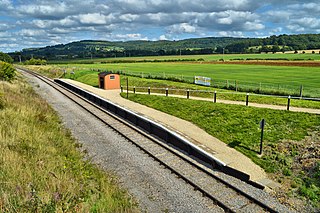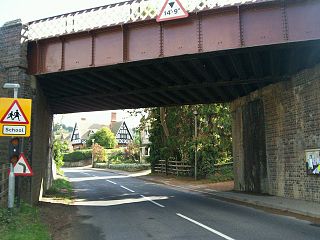
The Gloucestershire Warwickshire Steam Railway is a volunteer-run heritage railway which runs along the Gloucestershire/Worcestershire border of the Cotswolds in England.

Cheltenham Spa railway station serves the spa town of Cheltenham in Gloucestershire, England. Situated on the Bristol-Birmingham main line, it is managed by Great Western Railway, despite most services being operated by CrossCountry which does not manage any stations. It is located about one mile from the town centre. The official name of the town is simply Cheltenham but, when the station was renamed in 1925, the London, Midland and Scottish Railway chose to add Spa to the station name. It is a key regional interchange and is the busiest station in Gloucestershire, as well as one of the busiest railway stations in South West England.
The Bristol and Gloucester Railway was a railway company opened in 1844 to run services between Bristol and Gloucester. It was built on the 7 ftBrunel gauge, but it was acquired in 1845 by the 4 ft 8+1⁄2 instandard gauge Midland Railway, which also acquired the Birmingham and Gloucester Railway at the same time.

Winchcombe railway station is a heritage railway station which serves the town of Winchcombe in Gloucestershire, England. The stations itself is actually located in the nearby village of Greet. It is located on the Honeybourne Line which linked Cheltenham and Stratford-upon-Avon and which was opened by the Great Western Railway in 1906. The station closed to passengers in 1960, although the line itself remained open for freight and diversionary use until 1976, when a freight train derailed near Winchcombe and damaged the track.

Stratford-upon-Avon railway station is the southern terminus of the North Warwickshire Line and Leamington–Stratford line, serving the market town of Stratford-upon-Avon in Warwickshire, England. The station is served by West Midlands Trains (WMT) and Chiltern Railways.

Toddington railway station serves the village of Toddington in Gloucestershire, England. Since 1984 it has been the main base of operations for the heritage Gloucestershire Warwickshire Railway.

Honeybourne railway station serves the village of Honeybourne in Worcestershire, England. Opened in 1853, it is on the Cotswold Line and was formerly a busy junction with five platform faces, also serving trains on the Great Western Railway's Honeybourne Line between Cheltenham Spa and Stratford-upon-Avon, which formed part of a strategic route between the West Midlands and the West of England.
The Oxford, Worcester and Wolverhampton Railway (OW&WR) was a railway company in England. It built a line from Wolvercot Junction near Oxford to Worcester, Stourbridge, Dudley and Wolverhampton, as well as some branches.
The Cheltenham and Great Western Union Railway was a railway company intended to link Cheltenham, Gloucester and Swindon, in England. It was authorised in 1836 but it found it very hard to raise money for the construction, and it opened only a part of its line, between Swindon and Cirencester, in 1841. It sold its business to the Great Western Railway, which quickly built the line through to Gloucester in 1845 and Cheltenham in 1847; part of that route was shared with other companies.

Helmdon Village railway station on the Stratford-upon-Avon and Midland Junction Railway (SMJ) served the Northamptonshire village of Helmdon between 1872 and 1951. It was one of two stations serving the lightly populated rural area, the other being Helmdon railway station on the Great Central Main Line, and its closure marked the beginning of the years of decline for the SMJ line.
Stratford-upon-Avon Racecourse Platform was a railway station on the Stratford upon Avon to Cheltenham section of the Honeybourne Line. Located one mile south of the town centre, its purpose was to serve Stratford Racecourse. It closed in 1968 as a result of falling passenger numbers.

Chambers Crossing Halt railway station was a timber-framed railway halt on the Stratford-upon-Avon to Cheltenham section of the Honeybourne Line. The station was located two miles south-west of Stratford upon Avon. The site of the station is now part of the Stratford greenway and may in future form part of the Gloucestershire Warwickshire Railway's northern extension from Toddington.

Cheltenham Spa Malvern Road railway station was a station in the town of Cheltenham.
Cheltenham High Street railway station was built by the Midland Railway to serve the north-western part of Cheltenham.
Laverton Halt railway station was a halt on the Honeybourne Line from Honeybourne to Cheltenham which served the hamlet of Laverton in Gloucestershire between 1905 and 1960.

Hayles Abbey Halt railway station is a halt opened by the Great Western Railway on the Honeybourne Line from Honeybourne to Cheltenham which served the hamlet of Hailes in Gloucestershire, as well as the nearby Hailes Abbey, between 1928 and 1960. The line through the site of the station was reinstated in 1985 and opened in 1987 by the Gloucestershire Warwickshire Railway, although for many years no new halt was provided. The halt was eventually reopened on 5 June 2017 after being rebuilt by volunteers. Unlike the original, however, it only has a single platform. It lies between Toddington and Winchcombe stations.

Gretton Halt railway station was a halt opened by the Great Western Railway on the Honeybourne Line from Honeybourne to Cheltenham which served the small village of Gretton in Gloucestershire between 1906 and 1960. The line through the site of the station was reinstated in 1997 by the Gloucestershire Warwickshire Railway, although no new halt was provided.

Weston-sub-Edge railway station is a disused station on the Honeybourne Line from Stratford-upon-Avon to Cheltenham which served the village of Weston-sub-Edge in Gloucestershire between 1904 and 1960.

Willersey Halt railway station served the village of Willersey, Gloucestershire, England between 1904 and 1960.
The Stratford on Avon Railway was a branch railway line opened in 1860, to connect the town of Stratford-upon-Avon to the Great Western Railway main line at Hatton, in England. It was worked by the GWR. In 1861 it was connected through Stratford to a branch line from Honeybourne, and this later enabled the development of a through mineral traffic. The company was absorbed by the GWR in 1883.















